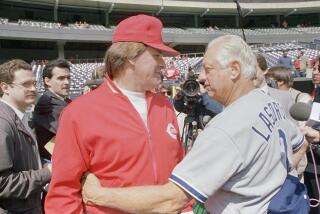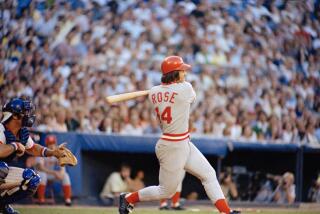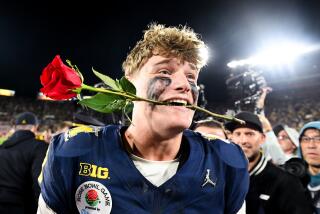COLLEGE FOOTBALL: BOWL WEEK : At Michigan State, the Spirit of Duffy Still Moves Team
- Share via
The spirit of Duffy Daugherty is alive and well at Michigan State.
Who else but Duffy would claim that he had picked out a site for his Rose Bowl team to stay because it had a nice place where his 80-year-old mother could go shopping?
Well, George Perles could.
“Mother will be 80 next Tuesday and she doesn’t get around like she used to, so I thought Newport Beach would be a good place to stay,” the Michigan State coach said. “There are plenty of places for her and my wife to spend their money.”
It could have been something right out of Daugherty’s quotebook.
Daugherty died last Sept. 25 at 72 in Santa Barbara, and Perles’ team will play USC Friday in the 74th Rose Bowl game--a combination of circumstances that saddens Perles.
“That’s the one thing that keeps this from being the end of a perfect season, the fact that Duffy couldn’t be around to enjoy it,” Perles said. “He would have been right in his element, giving interviews, filling writers’ notebooks full of Duffyisms and making us all feel a little better.”
Daugherty coached for 19 years at Michigan State, guiding the Spartans to two Big Ten championships and two Rose Bowl games between 1954 and 1972, when he retired. He also coached an obscure defensive tackle from Detroit named George Perles.
“I owe the fact that I’m here as coach of Michigan State to Duffy,” Perles said. “I’m really not Duffy’s son, but he took care of me like a son. I loved the guy. He had a great influence on my life as well as my career.”
Perles was recruited by Daugherty and had become the No. 2 tackle in his sophomore year when he injured his knee in the Wisconsin game, ending his playing career.
“Duffy talked me into staying with the program and working with him as a student assistant, coaching the freshmen.”
Perles stayed long enough to not only get his bachelor’s degree in physical education but also a master’s degree, a wife, Sally, and a son and daughter. He left MSU in 1961.
“With a family to support, I needed a good job and Duffy got me one as an assistant coach at St. Rita High in Chicago,” Perles said. “And the next year, he got me what I considered the best high school coaching job in Detroit, at St. Ambrose.”
After three years, during which St. Ambrose won two city championships, Daugherty was on the phone again.
“He told me that John McVay had an assistant’s job open at Dayton, and I could have it if I wanted,” Perles said. “I went over there for a couple of years and then Duffy brought me back to East Lansing as his assistant for five years. Those were five great years I had with him.
“In all, I spent 10 years with Duffy, either as a player, student coach or an assistant. We even went on vacations together. I left in 1971 to go to the Steelers as an assistant to Chuck Noll. That was the year before Duffy left.”
Daugherty remained at Michigan State as a special assistant to the vice president for two years after retiring as football coach. He and his family moved to Santa Barbara in 1975.
When Daugherty brought his first Michigan State team to the Rose Bowl in 1956, it was like a breath of fresh spring air to Southern California writers.
Ray Eliot of Illinois had set the standard for secretiveness and noncooperation by Big Ten coaches when he ordered Southland writers out of the Brookside Park practice field in Pasadena in December 1946, the first year of the Rose Bowl pact with the old Pacific Coast Conference.
Woody Hayes and Ohio State were here for the 1955 game, and he allowed no writers to talk to any of his players. It wasn’t very healthy to try to talk with him, either.
The volatile Hayes made that clear when he punched out a press photographer on the sidelines before the New Year’s Day game.
Then came Duffy, introducing his players to everyone, letting them talk, opening up practice to the press and shocking his coaching colleagues with statements such as: “Secrets? There are no secrets in this day of scouting and motion pictures. I know what (UCLA Coach) Red Sanders is going to use against us and he knows what we will use, so you guys might as well come in and look around.”
It has been 22 years since Duffy brought the last Michigan State team here in 1966, so the openness of Perles this year is as refreshing as it was when Daugherty opened things up.
“I’m here to have fun, to have fun with the team,” Perles said Monday as he prepared to leave for the Spartans’ tour of Disneyland. “That’s something I learned from Duffy, to have fun. You couldn’t be around Duffy as long as I was without some of him rubbing off on you.
“I’m looking forward to going to Disneyland. I’ve never been there, never had any reason to go. I’ve never been to a zoo, either. Of course, we’ve raised four children.”
Daugherty’s memory on the Michigan State campus is assured by the Duffy Daugherty Football Building, which includes an indoor field larger than the one in Spartan Stadium. But the memory of the man himself began to fade around East Lansing when two outsiders, Denny Stolz and Darryl Rogers, coached the team for seven years after Daugherty left.
“George (Perles) has revived the Daugherty atmosphere around the school,” said Nick Vista, Michigan State public relations director who worked with Daugherty for 18 of his 19 seasons there. “There is no question that his influence is still felt, more so since Perles came in as head coach. He has resurrected that atmosphere.”
What Spartans refer to as the Daugherty connection is responsible, in a way, for the recruiting of two key black players from Florida--All-American running back Lorenzo White from Fort Lauderdale and quarterback Bobby McAllister from Pompano Beach.
“Duffy was one of the first coaches at a major school to recruit black players from the South,” Vista said. “He came from poor surroundings, from a coal miner’s family in western Pennsylvania, and he never lost his compassion for the poor, the underdog. He always said he’d rather help a young man from a poor background get an education than a well-to-do kid.”
Daugherty’s powerful teams in the ‘60s were anchored by such black players as George Webster, Bubba Smith and Gene Washington from Texas, Jimmy Raye from North Carolina and Charles Thornhill from Virginia.
Duffy was speaking at a football clinic in Beaumont, Tex., in 1960 where he met a black high school coach named Willie Ray Smith.
“Blacks weren’t allowed in bars in Texas back then,” Daugherty recalled a few years ago, “so I invited Willie Ray and some other black coaches up to my hotel room. I ordered a couple of cases of beer, and we sat there and talked football.
“Not long after that, I got a call from Willie Ray asking me if I’d take his son on a scholarship and teach him to be a man. I told him teaching him to be a man was his responsibility, I would teach him to be a football player.”
Willie Ray Smith’s son was the one they call Bubba.
One of the last of Duffy’s recruits was a quarterback from Fayetteville, N.C., named Charlie Baggett. When Perles returned to Michigan State, he brought Baggett back to coach the wide receivers--and recruit in the South. It was Baggett who bagged White and McAllister for the Spartans.
Daugherty was proud of his pioneering reputation. During a game in the early ‘70s between Tennessee and Alabama, Duffy watched as running back Wilbur Jackson became Alabama’s first black player and Tennessee’s Condredge Holloway became the first black quarterback at a major southern school.
“If it had been five years earlier, they would both have been playing for me,” Duffy said at the time. “It was nice to see.”
Three weeks before Daugherty died, the Spartans opened the season on Labor Day night against USC. Daugherty was in Cottage Hospital in Santa Barbara, battling a heart disease, but he sent Perles a telegram, which the coach read to his team.
“It was just a message wishing us well, that he was thinking of us even if he couldn’t be there,” Perles said. “It wasn’t one of those win-one-for-the-Gipper type of things, it was just a few words from an old friend. Duffy was that kind of a man, always thinking about others.”
Michigan State officials held a memorial service for Daugherty in East Lansing on Nov. 14, the morning of the Indiana game.
“It was ironic because we planned the memorial a month ahead of time, having no idea that the Indiana game would decide the conference championship,” Perles said. “I invited Francie (Mrs. Daugherty) and she came and it was a very emotional time. The student center was packed with his friends, former players and fellow coaches.
“Today’s players didn’t know him, except what they heard, and that’s too bad, but it has been 16 years since he was coaching. Fellows like Lorenzo White were only 5 years old then.”
Perles’ best times with Duffy, away from the football field, were at press conferences and on golf courses.
“He made every interview a happening,” Perles said. “All the writers loved it when he’d say something like, ‘We’re small but we make up for it by being slow,’ or when writers would ask who he was happiest to see returning from the previous season, he’d say, ‘Me.’
“One time, he was explaining football to a crowd of fans and explained that a tight end is not intoxicated, a split end often lacks a dual personality and an ineligible receiver may be entirely eligible for marriage.
“We took our vacations together, playing golf. One year we went to Ireland and Scotland and played all the great courses and no one had more fun that Duffy. All the caddies were old men and they loved Duffy . . . because he loved older people.
“I loved to play golf with him because he played the game the way it ought to be played, for fun. Of course, he cheated,” Perles added. “If Duffy’s ball came to rest behind a clump of grass, he’d kick it out and say innocently, ‘You don’t want me to break my club, do you?’
“He’d do everything he could to beat you out of a buck or two, and then, after the round, he’d sit and spend 10 times what he’d made, buying drinks and dinner.”
The gang that hangs around the pro shop at the Montecito Country Club in Santa Barbara could relate to that. Duffy, a 14-handicap golfer, played the hillside course three or four times a week during the 12 years he lived there.
The Duffy’s Duffers tournament, which Daugherty held for coaches, players and those he identified as “sports celebrities,” will be perpetuated in his honor. Brad Van Pelt, one of Daugherty’s former All-Americans, has taken over running the tournament.
“Around the pro shop, there’s hardly a day passes that someone doesn’t bring up Duffy’s name,” said Larry Talkington, head professional at Montecito. “He was a legend here. There was no such thing as a stranger when Duffy was around. He knew everyone, and if he didn’t, he made it his duty to meet them. Probably in my lifetime, I’ll never meet another one like him.”
George Perles probably comes as close as anyone.
At times, when Perles squints into the sun and his face turns ruddy, he almost looks like his old mentor--at least as much as the son of a Lithuanian factory worker could look like the son of an Irish coal miner.
More to Read
Go beyond the scoreboard
Get the latest on L.A.'s teams in the daily Sports Report newsletter.
You may occasionally receive promotional content from the Los Angeles Times.










